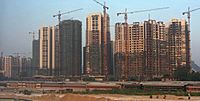
Photo from wikipedia
Industrialization and urbanization are critical paths to modernization for a country or region. The coordination of industrialization and urbanization fosters the development of a regional economy. In academic circles, this… Click to show full abstract
Industrialization and urbanization are critical paths to modernization for a country or region. The coordination of industrialization and urbanization fosters the development of a regional economy. In academic circles, this is usually measured by the IU ratio (ratio of labor industrialization rate to urbanization rate) and the NU ratio (ratio of non-agricultural employment rate to urbanization rate). However, these methods are inapplicable to large countries’ inland areas. The traditional methods failed to explain the real situation and produced contradictory results. The IU ratio shows that industrialization lags behind urbanization, while the NU ratio shows that industrialization is ahead of urbanization. According to studies conducted in the Sichuan Province of China, through comparison with Jiangsu Province, it is found that the non-agricultural employment growth is not dependent on the development of local industrialization, and rural-urban migration is not entirely dependent on the evolution of the non-agricultural employment rate. Other factors that promote urbanization, such as the country’s capital policies and funds for migrant labor force transfer, should also be considered. This research attempts to improve the traditional methods for measuring the degree of urbanization and industrialization synergy in inland areas. The new empirical approach can effectively identify the critical characteristics of urbanization in inland provinces, such as the development of non-agricultural employment with external assistance and urban migrants “unrelated to employment opportunities”. Based on these key characteristics, it can provide the basis for local urbanization policy formulation.
Journal Title: International Journal of Environmental Research and Public Health
Year Published: 2022
Link to full text (if available)
Share on Social Media: Sign Up to like & get
recommendations!